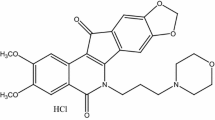Summary
Trough and peak concentrations as well as the elimination kinetics of the antimycotic agent terbinafine and 3 metabolites were investigated following multiple-dose administration of terbinafine 250mg daily for 4, 12 and 48 weeks. Plasma, sebum and tissues such as the stratum corneum, dermis-epidermis, hair and nails were analysed. The elimination of all compounds was multiphasic, being faster initially. Mean terminal elimination half-lives of the parent drug determined in plasma and tissues ranged from 18 to 28 days, and were in the same range as those of the metabolites (21 to 28 days). The slowest terminal elimination of terbinafine was observed from the dermis-epidermis and from keratinic tissues like hair and nails. Trough plasma concentrations of terbinafine were highly consistent in all studies, indicating an accumulation (12.6- to 18.5-fold) after multiple-dose treatment. However, peak concentrations of terbinafine accumulated only slightly (1.3-fold).
In plasma, the kinetics of the metabolites were similar with regard to their terminal elimination half-life. Like the parent drug, trough concentrations of the N-demethylated metabolite accumulated (8- to 12.9-fold) after multiple-dose administration, but the peak concentrations did not. In contrast, the 2 carboxy metabolites accumulated only slightly (1.6- to 2.7-fold) under the same conditions.
Similar content being viewed by others
References
Petranyi G, Ryder NS, Stütz A. Allylamine derivatives: New class of synthetic antifungal agents inhibiting fungal squalene epoxidase. Science 1984; 224: 1239–42
Clayton YM. In vitro activity of terbinafine. Clin Exp Dermatol 1989; 14: 101–3
Kovarik JM, Kirkesseli S, Humbert H, et al. Dose-proportional pharmacokinetics of terbinafine and its N-demethylated metabolite in healthy volunteers. Br J Dermatol 1992; 126Suppl. 39: 8–13
Ryder NS, Mieth H. Allylamine antifungal drugs. Curr Top Med Mycol 1992; 4: 158–88
Ryder NS. Specific inhibition of fungal sterol biosynthesis by SF 86-327, a new allylamine antimycotic agent. Antimicrob Agents Chemother 1985; 27: 297–300
Jensen JC. Clinical pharmacokinetics of terbinafine. Clin Exp Dermatol 1989; 14: 110–4
Jensen JC. Pharmacokinetics of Lamisil® in humans. J Dermatol Treatment 1990; 1Suppl. 2: 15–8
Zehender H, Denouël J, Roy M, et al. Simultaneous determination of terbinafine (Lamisil®) and 5 metabolites in human plasma and urine by high performance liquid chromatography using on-line solid-phase extraction. Accepted for publication in J Chromatogr
Faergemann J, Zehender H, Jones T, et al. Terbinafine levels in serum, stratum corneum, dermis-epidermis (without stratum corneum), hair sebum and eccrine sweat. Acta Derm Venereol 1990; 71: 322–6
Faergemann J, Zehender H, Denouël J, et al. Levels of terbinafine in plasma, stratum corneum, dermis-epidermis (without stratum corneum), sebum, hair and nails during and after 250mg terbinafine orally once per day for 4 weeks. Acta Derm Venereol 1993; 73: 305–9
Faergemann J, Zehender H, Millerioux L. Levels of terbinafine in plasma, stratum corneum, dermis-epidermis (without stratum corneum), sebum, hair and nails during and after 250mg terbinafine orally once per day for 7 and 14 days. Clin Exp Dermatol 1994; 19: 121–6
Finlay AY. Pharmacokinetics of terbinafine in the nail. Br J Dermatol 1992; 126Suppl. 39: 28–32
Jones T, Villars V. Lamisil® (Terbinafine). A new antifungal drug. Clin Res Bull 1989; 6: 19–27
Goodfield MJD, Andrew L, Evans EGV. Short term treatment of dermatophyte onychomycosis with terbinafine. BMJ 1992; 304: 1151–4
Acknowledgements
All studies considered for the pharmacokinetic evaluations in this study were sponsored by Sandoz Pharma Limited.
Author information
Authors and Affiliations
Rights and permissions
About this article
Cite this article
Zehender, H., Cabiac, M.D., Denouël, J. et al. Elimination Kinetics of Terbinafine from Human Plasma and Tissues following Multiple-Dose Administration, and Comparison with 3 Main Metabolites. Drug Invest 8, 203–210 (1994). https://doi.org/10.1007/BF03258479
Published:
Issue Date:
DOI: https://doi.org/10.1007/BF03258479




